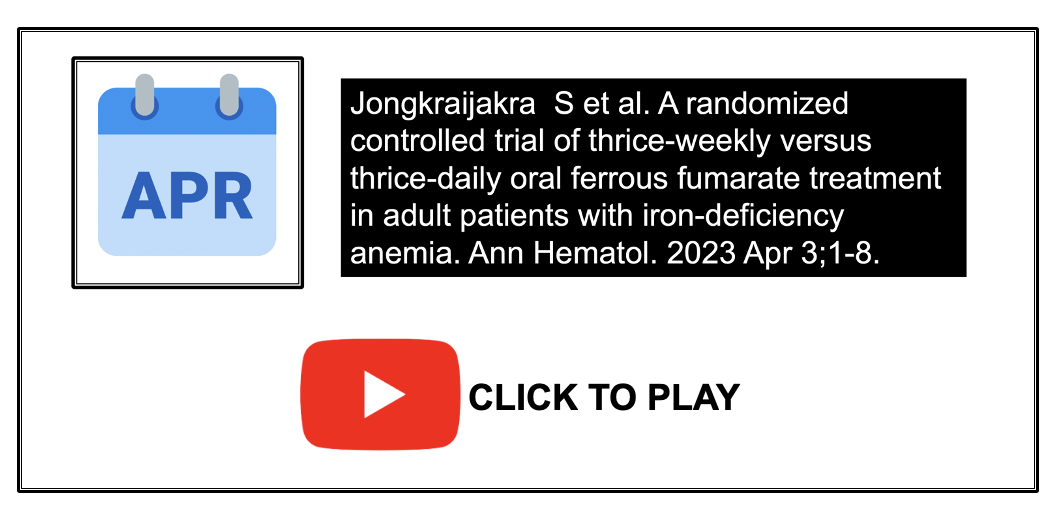Treating Iron Deficiency Anemia: Three Times Weekly Iron Therapy May Give Similar Benefits to Three times Per Day
Thrice Weekly Iron Non-Inferior to Thrice Daily Iron Supplementation
Several prior studies have shown that use of oral iron therapy every other day rather than daily could have similar efficacy and less gastrointestinal effects in the treatment of patients with iron deficiency anemia.
(See prior article. Every Other Day iron Therapy)
Jongkraijakra S et al 2023
In a new study, authors from Thailand reported results from a prospective open-labeled randomized controlled study which was designed to compare whether 200 mg ferrous fumarate thrice-weekly (TIW) was not inferior to a thrice-daily (TID) regimen. The authors also wished to assess the incidence of adverse events (AEs) between two regimens in treating adult patients with IDA.
Inclusion Criteria
The authors recruited patients aged > 18 years and proven IDA with criteria of Hb < 12 g/dL in females or < 13 g/dL in males and serum ferritin level of < 30 ng/mL.
Primary and Secondary Endpoints
The primary endpoint was either an increase in Hb ≥ 3 g/dL, having Hb of 12 g/dL in females or 13 g/dL in males at the 12th week of treatment. Secondary outcomes included adverse events (AEs), red blood cell indices, iron profiles, and patient compliance.
Results
In total, 64 patients were randomized: 32 in the TIW arm and the other 32 in the TID arm. The trial demonstrated non-inferiority of three times weekly iron therapy compared to three times daily.
The iron profile response of the TID arm was earlier than the TIW arm. However, almost all patients recovered from anemic symptoms at week 4, and hematologic responses were not found to be different at week 12.
The mean Hb level in the TID arm was significantly higher than the TIW arm at week 4 (9.9 vs. 10.8 g/ dL, respectively, p = 0.040). However, the mean Hb levels were not substantially different in either arm at week 12 (11.9 vs. 12.4 g/dL, p = 0.188).
The proportion of patients who had serum ferritin > 30 ng/mL was not different between the two groups at week 12 (64.3% vs. 73.1%, p = 0.430)
There were more gastrointestinal releated AEs (nausea and epigastric discomfort) in the TID arm.
Summary
In conclusion, this study showed that the TIW was non-inferior to the TID iron treatment of IDA patients at 12 weeks but had fewer AEs and lower costs.
REFERENCE
Jongkraijakra S et al. A randomized controlled trial of thrice-weekly versus thrice-daily oral ferrous fumarate treatment in adult patients with iron-deficiency anemia. Ann Hematol. 2023 Apr 3;1-8.
This article was written by Dr. Jeff Donovan, a Canadian and US board certified dermatologist specializing exclusively in hair loss.

